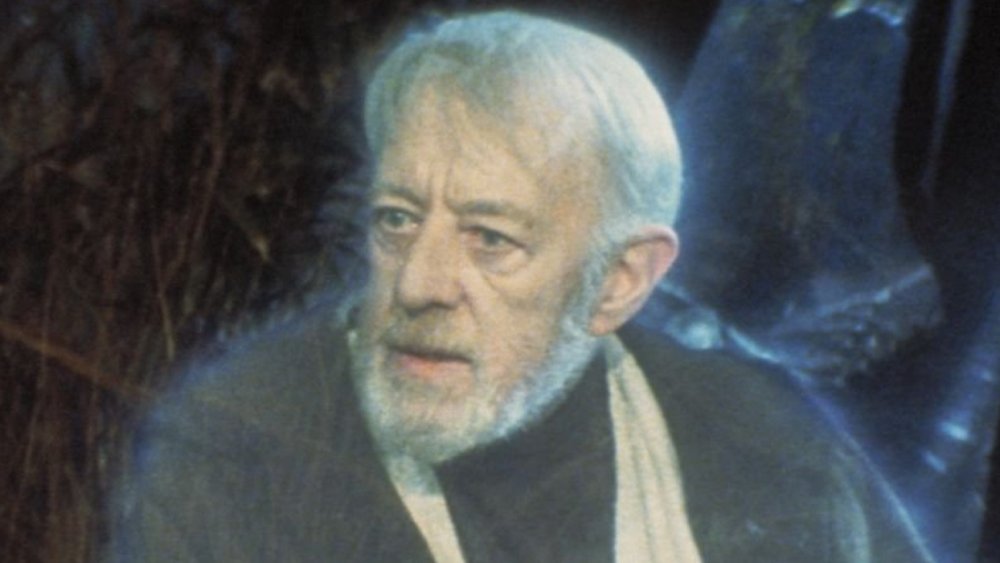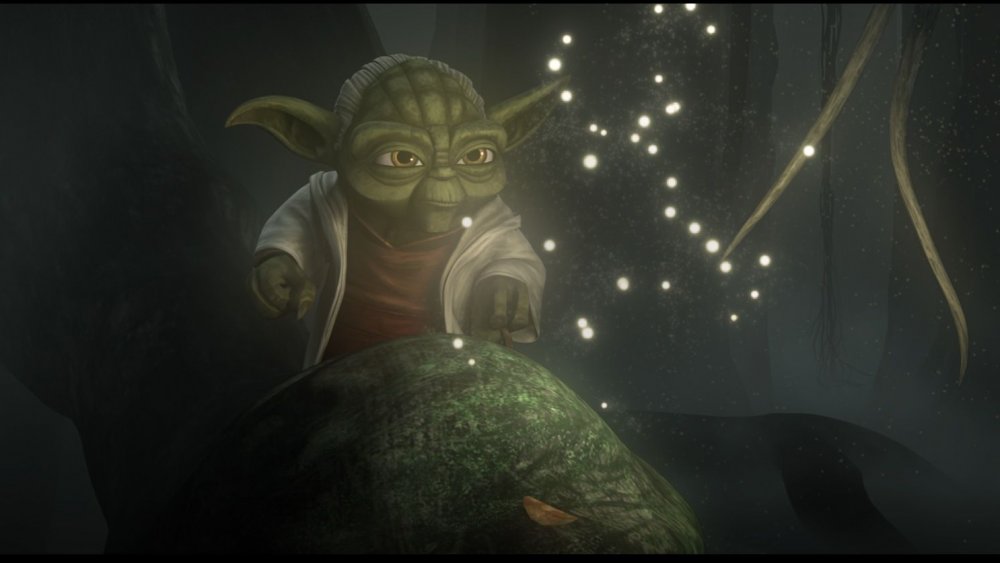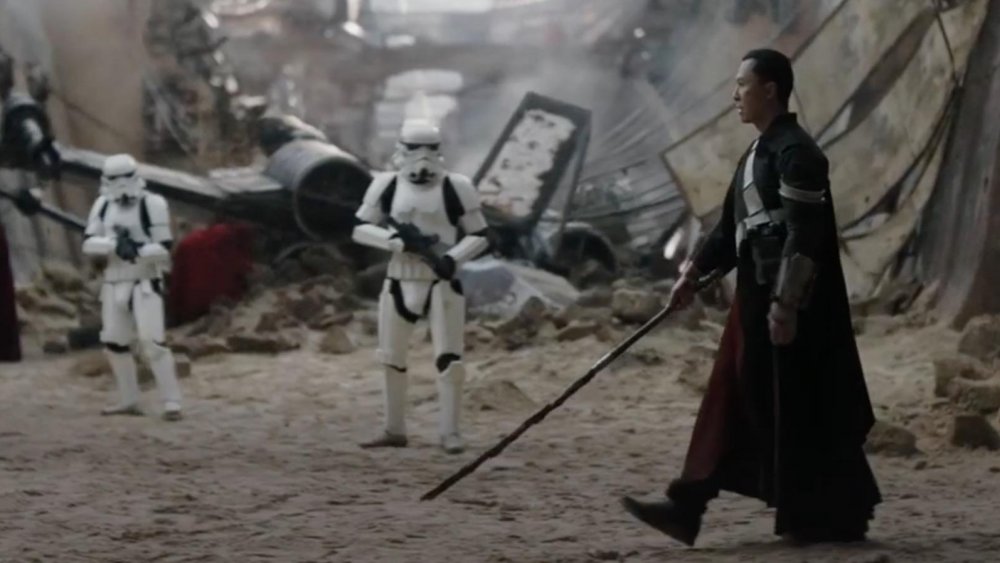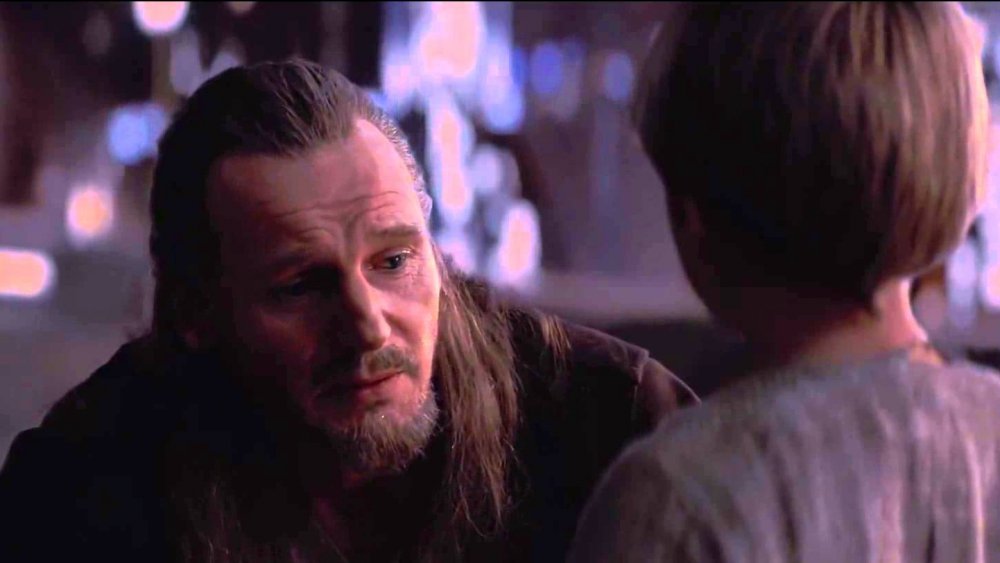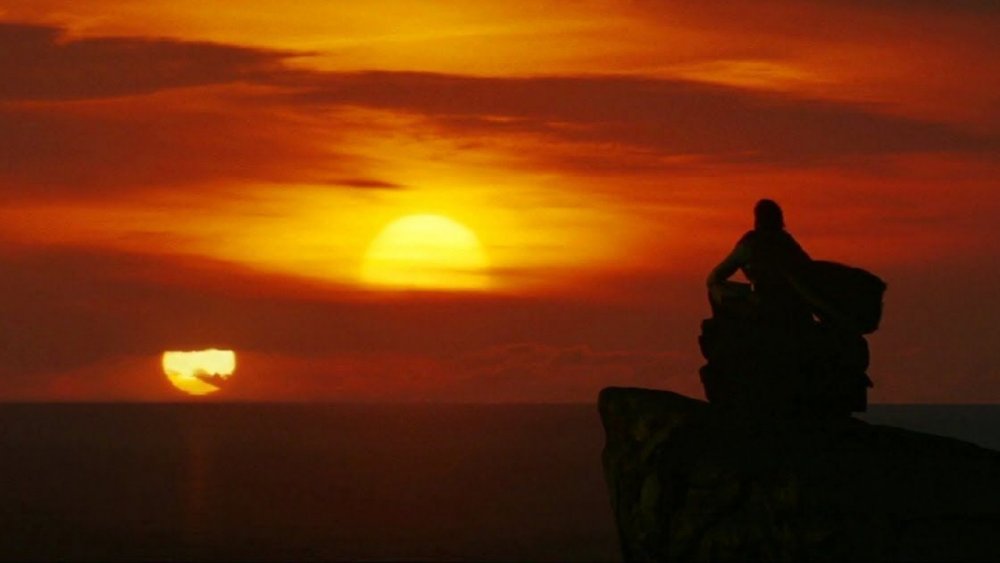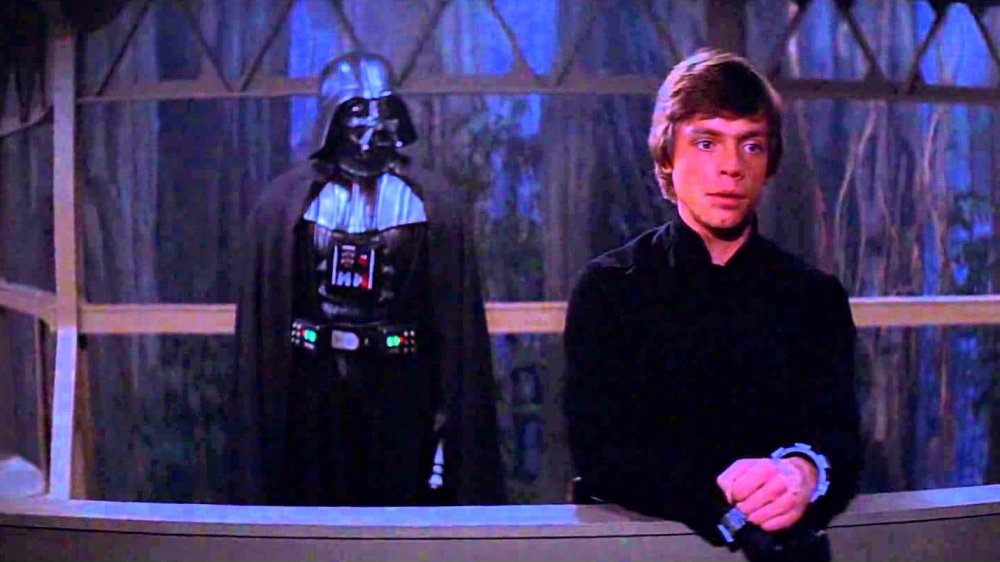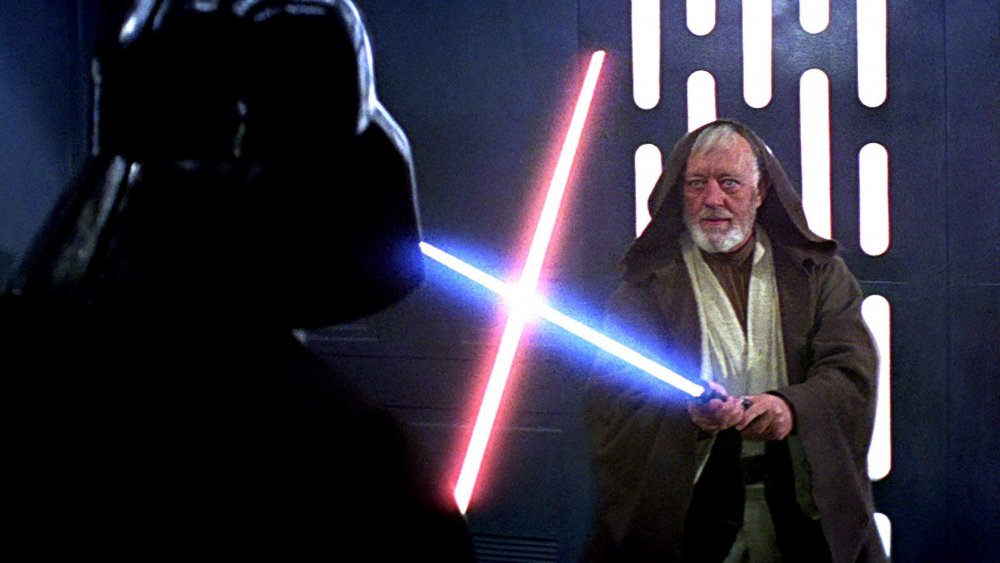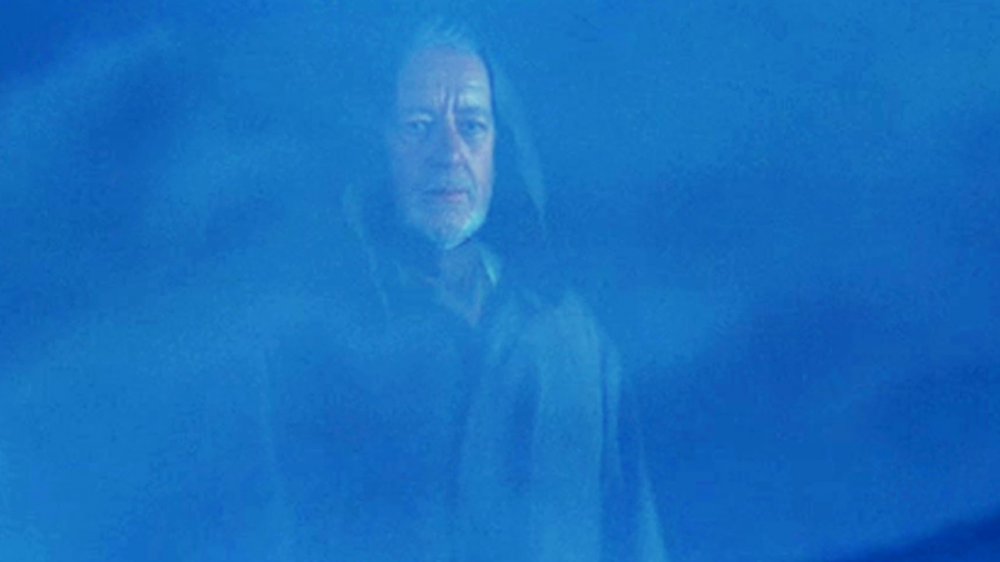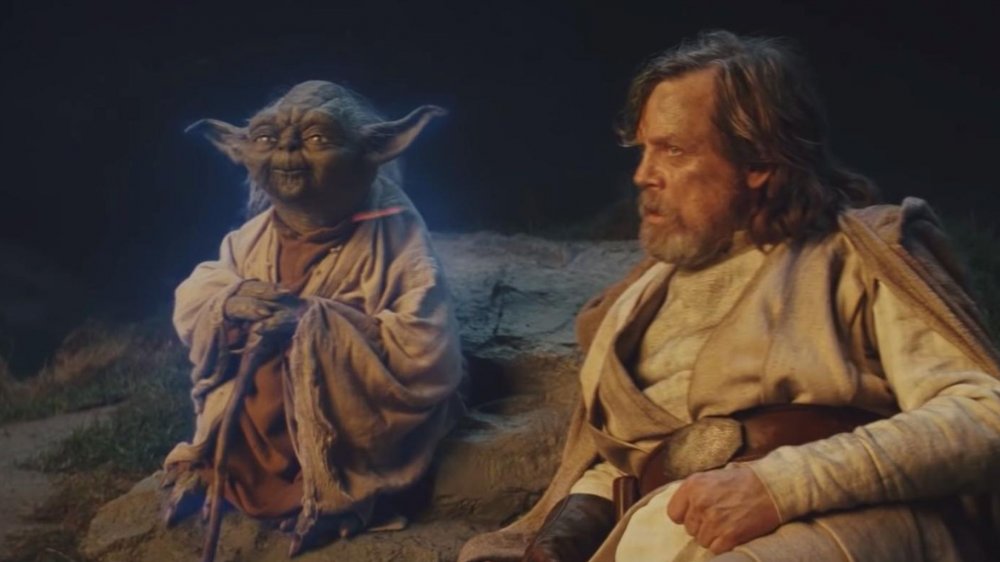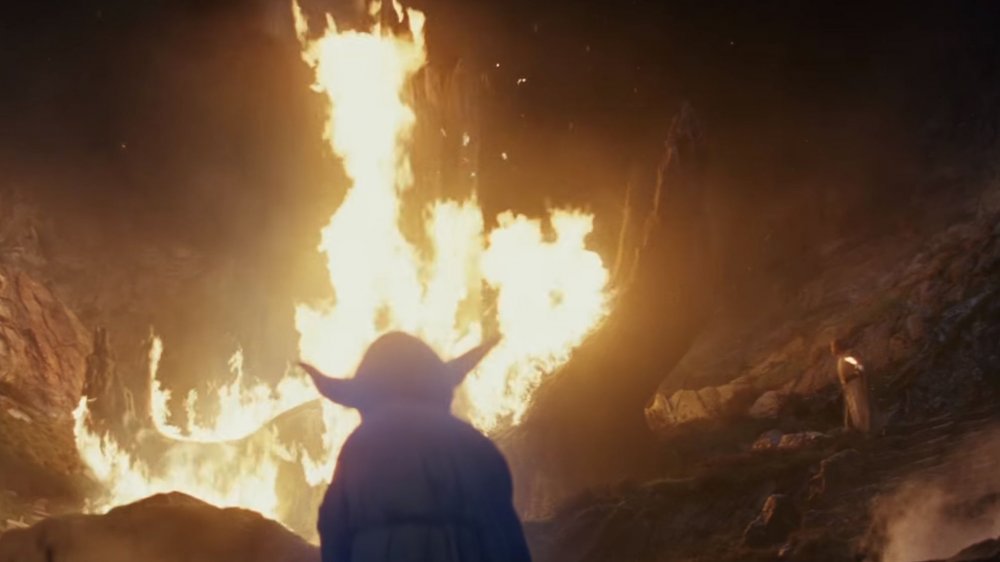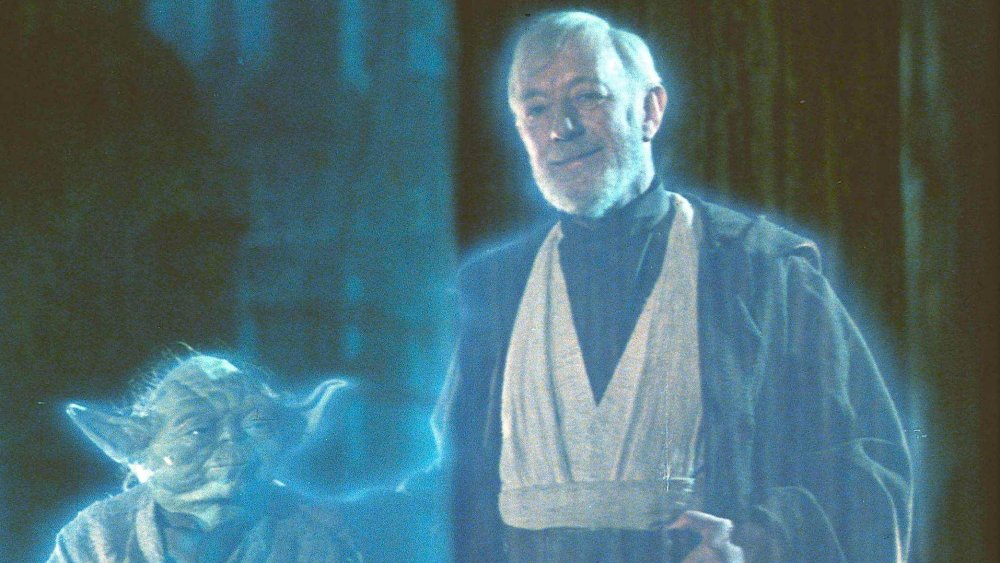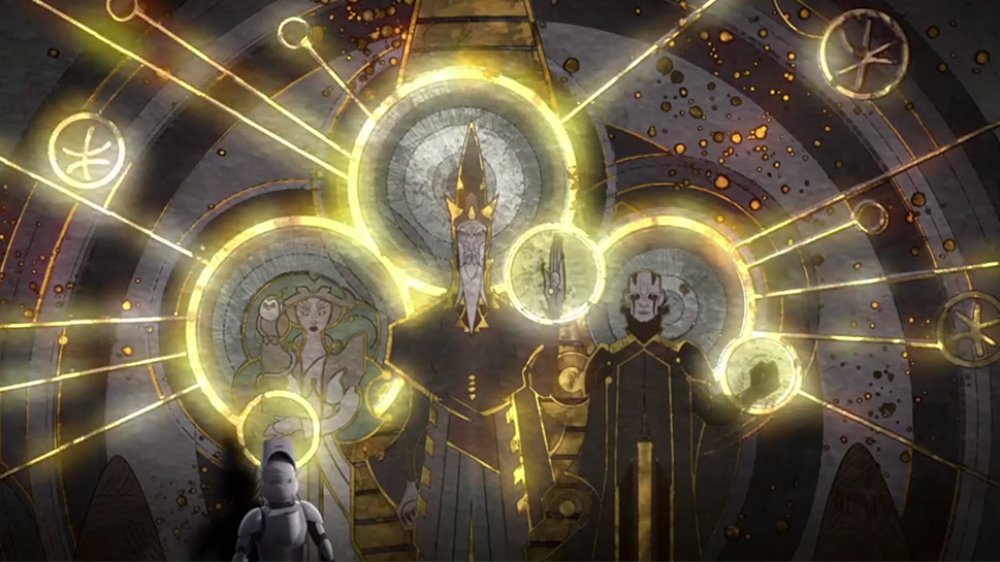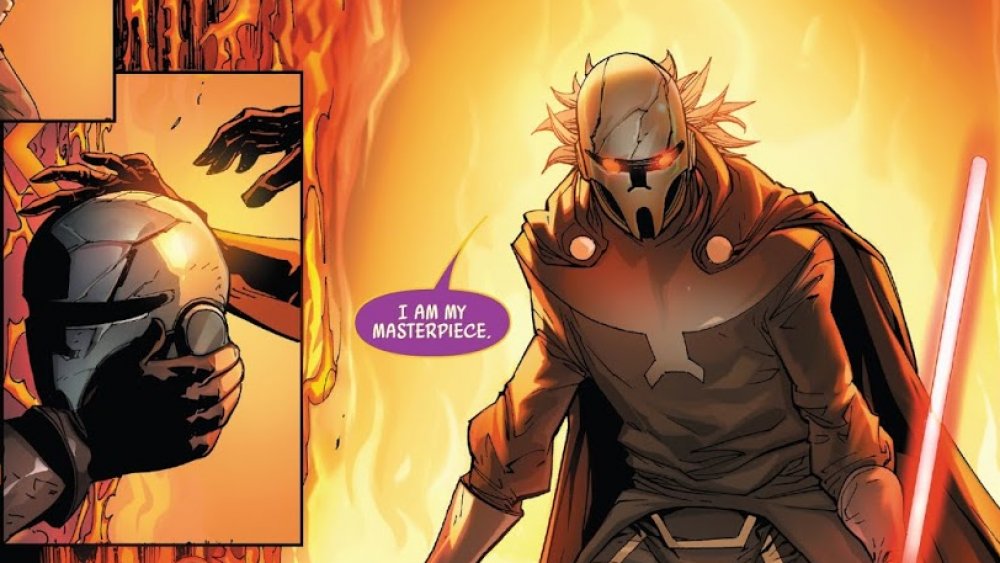Star Wars: The Untold Truth Of Force Ghosts
Alongside lightsabers, droids, and moon-like space stations with fatal design flaws, life after death is a signature feature of the Star Wars franchise. Long before Darth Maul was granted his improbable reprieve from certain doom solely on the merit of being too cool to kill, the Jedi were cheating death all the way back in 1977's Star Wars: A New Hope. In that groundbreaking first film, Obi-Wan's sacrifice allows Luke Skywalker and company to escape from the Death Star. Still, it seems like an unfairly high price to pay ... until Obi-Wan reappears in 1980's The Empire Strikes Back as a translucent ghost with a groovy blue glow. Sure, we'd heard Obi-Wan's voice in Luke's head urging him on, but without the context that the later films provide, that could be interpreted as an inspirational memory. By the time Blue Ghost Obi-Wan is chilling on a log in Empire, though, all doubt is removed: The Jedi can survive death!
Well, sort of. Over the course of the 40 years that have passed since ghostly Obi-Wan debuted, a galaxy of sequels, prequels, animated series, comics, novels, and games have written and rewritten the story. With Disney's acquisition of the franchise, some material is no longer considered canon, while some has been relegated to the limbo of "Star Wars legend" status. But the lore surrounding the Jedi practice of transcending death has only deepened with age. Let's take a look at the untold truth of Force ghosts.
Obscured origins
While Obi-Wan is the first Jedi that audiences see return as a Force ghost — or "Force spirit" as they're now officially called — it is Qui-Gon Jinn who first masters the projection of his consciousness beyond death. This idea is first introduced in a brief exchange between Obi-Wan and Yoda at the end of Revenge of the Sith, and expanded on in season six of the animated series, Star Wars: The Clone Wars. Qui-Gon is seen contacting Yoda from beyond the grave in the form of a cool light show, thanks to an ability he's picked up postmortem in the "Netherworld of the Force." His spirit is given posthumous instruction by the Force Priestesses, five mysterious beings living on a "Force planet" known as the "Wellspring of Life."
A deleted scene from Revenge of the Sith depicts another version of this story, with Qui-Gon saying that he learned to transcend death from a shaman of the Whills, a community of Force-sensitive beings best known for their extensive record of the galaxy's history. Both versions are considered canon, leading many fans to posit that Qui-Gon's training from the shaman was (ahem) cut short by Darth Maul, and completed by the Force Priestesses.
Where there's a Whill...
The Whills are one of the oldest creative elements of the Star Wars universe, dating back to creator George Lucas' earliest drafts of Star Wars, entitled, "The Journal of the Whills." Despite being pivotal to both the history of the franchise and in-universe lore, Lucas' own description of the Whills has changed repeatedly over the years.
Originally presented as immortals observing and telling the stories of Star Wars — perhaps as the authors of those signature opening crawls — the Whills evolved into "microbiotic beings that feed off the Force and control the entire universe," an idea that would later reappear as midi-chlorians in The Phantom Menace. They have since been referenced in a deleted scene from Revenge of the Sith, in which Qui-Gon states that he learned the transcendence of death from a "shaman of the Whills." They are further referenced by Donnie Yen's Rogue One character, Chirrut, a Force-sensitive, monk-like "Guardian of the Whills." This suggests that, whatever a "Whill" may be, the Force is strong with them.
Not "the" Force, but "a" Force
"May the Force be with you." The age-old catchphrase conjures the idea of a single unifying energy that "surrounds us, penetrates us, and binds the galaxy together." But there is actually more than one Force in the Star Wars universe, and we're not talking about "Light Side" versus "Dark Side," either. According to Star Wars lore, there is the Living Force, which is the energy of all living things in the present moment — this is the energy that Jedi tap into for their powers. Then there is the Cosmic Force, which can be seen as the energy of all space and time.
To become a Force ghost, a Jedi must become as one with the will of the Cosmic Force as they were with the will of the Living Force in life. This allows their consciousness to survive when their energy transfers from the Living to the Cosmic upon death. This is sometimes called "denying the will of the Force." As Qui-Gon explains in an episode of Star Wars: The Clone Wars, "All energy from the Living Force, from all things that have ever lived, feeds into the Cosmic Force, binding everything, and communicating to us through the midi-chlorians. Because of this, I can speak to you now."
Learning to die
In 2014, Disney announced the characters and concepts introduced in Star Wars' "expanded universe" of novels, comics, and games would no longer be considered canon. Up to that point, a variety of Star Wars stories referenced the rare ability to escape death and live on as a Force ghost as a long-lost Jedi skill. Apparently, those last-gen Force ghosts were long-lost too, because we never saw them.
The power to survive death as a shimmery blue Force ghost has since been retconned into an ancient teaching passed down by either the Whills, the Force Priestesses, or both. One fact remains consistent: It ain't easy. Becoming "at one with the Cosmic Force" in order to transform into a Force ghost upon death requires the kind of calm and contemplative mind typically only found in Jedi, as well as years of disciplined study. There's a reason why most of the successful practitioners we've seen — Obi-Wan, Yoda, and Luke — were hermits with a lot of time to spend in meditation.
Sacrifice play
"Denying the will of the Force" and "projecting your consciousness into the realm of the Cosmic Force" sounds kind of inexplicable, to be honest. It requires meditation upon mysterious deep knowledge, and, apparently, years of working in isolation. Well, except for one person ...
After decades of being the galaxy's most unbalanced absentee dad, Darth Vader gets to wipe the slate clean and return as Force ghost Anakin — either "emo Anakin" or "middle-aged rando Anakin," depending on the edition. That's because one surefire way to get the glow-y blue ghost treatment is for a Jedi to "commit a final act of selflessness that results in their death." Vader does so by saving Luke and betraying the Emperor, a fight he knows he can't survive. In the book Star Wars: The Annotated Screenplays, a scene deleted from Return of the Jedi explains that the Force ghosts of Yoda and Obi-Wan rescue Anakin's spirit from the Netherworld of the Force and complete his training. Either way, Anakin gets to skip the whole "meditating hermit" thing.
Get rid of the body
Obi-Wan's sacrifice in A New Hope was a stunning surprise for audiences in 1977, and still packs a punch for anyone seeing it with fresh eyes. Just like Vader nudging Obi-Wan's empty robes with the toe of his boot, viewers are left anxiously wondering if ol' Ben meant to do that. Part of a Jedi's training to "deny the will of the Force" involves transforming their bodies into pure energy. We see Obi-Wan, Yoda, and Luke all close their eyes in meditation before their deaths, which are followed by the vanishing of their bodies. We see Qui-Gon Jinn try it too, during his brief moment of respite during the "Duel of the Fates" scene. According to the novelization of Return of the Jedi, even Anakin's body transforms into energy after his death, leaving only the mechanical parts of Vader behind to be burned. We bet Luke wishes his dad could have managed that trick before he had to lug him up that ramp onto the lander.
Jedi see dead people
While it is clear that transforming into a Force ghost after death requires intense training and self-sacrifice, it can be inferred that even just seeing one may also require some level of skill. Because Force ghosts have only appeared in scenes where they are speaking to other Jedi, it is difficult to state definitively if they are invisible to non-Jedi, but evidence suggests this is the case. Han Solo doesn't see Obi-Wan appear to Luke on Hoth, after all. In fact, Leia, despite being Force-sensitive herself, somehow misses the three glowing dudes standing in the corner at the Ewoks' celebration, which suggests that training is required. This could, likewise, explain why Luke is only able to hear Obi-Wan's disembodied voice during the Battle of Yavin, but is able to faintly glimpse Obi-Wan through the snow on Hoth. It is only after training with Yoda that Luke sees Obi-Wan's apparition in full.
Objects pass through them ... except when they don't
Regardless of all this deeply layered lore, the movies and series are unclear about whether or not Force ghosts can interact with their physical surroundings. They are semi-transparent (light clearly passes through them) and can appear and vanish at will, but they also walk around and sit on logs like they did in their solid, mortal forms. In The Last Jedi, Yoda's ghostly walking stick even manages to thwack Luke on the head. So are they "ghosts" or not?
As with all things Star Wars, even this inconsistency has been explained. In the anthology book From a Certain Point of View, Qui-Gon Jinn's Force ghost appears to Obi-Wan while he's living as a hermit on Tatooine, and explains that he has continued to grow in his understanding of the ability, even after death. While he can initially only contact the minds of the living as a disembodied voice, he later becomes tangible enough to interact with the physical world.
They can use Force powers ... except when they can't
Yoda is seen in The Last Jedi wielding a heretofore unseen Jedi power: Drawing lighting from the sky to strike the tree library. Not only can he interact with his surroundings, he can demolish them with lightning. In A New Hope, Obi-Wan warns Darth Vader, "If you strike me down, I will become more powerful that you can imagine" — that seems like a pretty accurate description of an immortal, lightning-slinging Jedi. This, of course, begs the question: Why don't the Force ghosts help out more often? Obi-Wan graduates from mentor to guardian angel after his death and is always close by with advice and encouragement, but he never actually intervenes as Yoda does. In The Empire Strikes Back, Obi-Wan tries to discourage Luke from leaving for Cloud City, saying, "If you choose to face Vader, you do it alone. I cannot interfere." After Yoda's trick with the tree library, it is safe to say that Obi-Wan will not interfere, but whether he cannot is arguable.
Force ghosts can interact with each other
At the end of Return of the Jedi, an Ewok village hosts a celebration for all the heroes who survived till the end of the trilogy, as well as a few who didn't. Hanging in the corner like ethereal chaperones at a ghost prom are three shimmering blue figures: Obi-Wan, Yoda, and Anakin. Depending on the edition of the film you're watching, Anakin might be Hayden Christensen or he might be Sebastian Shaw. But while you were distracted by them, you may have missed a little moment shared between his fellow spirits. As if to say, "Those sure were some crazy star wars, weren't they, old chum," Obi-Wan's Force ghost rests his hand on the shoulder of Yoda's Force ghost. That's right: Sir Alec Guinness side-hugs a Muppet. No wonder this film is a classic. But the implication that comes with the camaraderie is that Force ghosts can interact with each other as if they were on the physical plane. Could they ghost high-five? Do they exist on a separate plane of reality that somehow meshes with ours, but not so much that Luke could shake Ghost Yoda's hand? Who knows. Ghost Yoda isn't telling.
They time travel
Complaints mounted that new, too-powerful Force abilities were imbalancing the story with each successive film of the Star Wars sequel trilogy. Strangely, the wildest Force power of all –- one associated with Force ghosts -– was actually introduced in the animated series, Star Wars Rebels, with little outcry. In episode 13 of season four, Ezra Bridger steps through the Force wielders' portal into the "World between Worlds," where he is able to commune with the voices of Jedi past and present. Ezra learns that the consciousnesses of dead Jedi travel through the World between Worlds, similar to George Lucas' description of the Netherworld of the Force. This is how the voices of long-dead Jedi encourage Rey in her moment of crisis — Force ghosts exist outside of normal time, as well as space. While the term "time travel" has yet to be associated with Star Wars, that's absolutely what the Force ghosts are doing.
Sith can live on after death too ... sorta
Denying the "will of the Living Force" in order to survive death requires one's consciousness be so perfectly attuned with the "will of the Cosmic Force" that it remains intact and transfers along with the rest of the being's energy. If submitting to the will of the Cosmic Force is hard for Jedi, it is impossible for the Sith, who don't like submitting to much of anything. Unable to transform themselves into Force ghosts, the Dark Side-aligned Sith have found other ways to survive beyond death, by binding some portion of their personality onto an object. In Star Wars Rebels, Ezra Bridger encounters the last vestiges of a Sith called "the Presence," that has bound her energy to a Sith holocron. Similarly, in Marvel Comics' 2018 miniseries, Star Wars: Darth Vader: Dark Lord of the Sith, the spirit of a long-dead Sith lord called Darth Momin possesses anyone who wears his mask. This is arguably not sentience like a Force ghost experiences, but it is not entirely dissimilar. Some part of these Sith does live on, grafted onto the artifact of their choosing. Perhaps this is why so many Sith Lords dig tchotchkes.
